|
A guideline in Hennepin County’s 2020 to 2025 Aquatic Invasive Species (AIS) prevention program evaluation report (PDF) is to “Improve Facilities.” This guideline has allowed county staff to work with both private and public partners at public water accesses throughout the county. This currently includes 18 access locations with 16 partners.
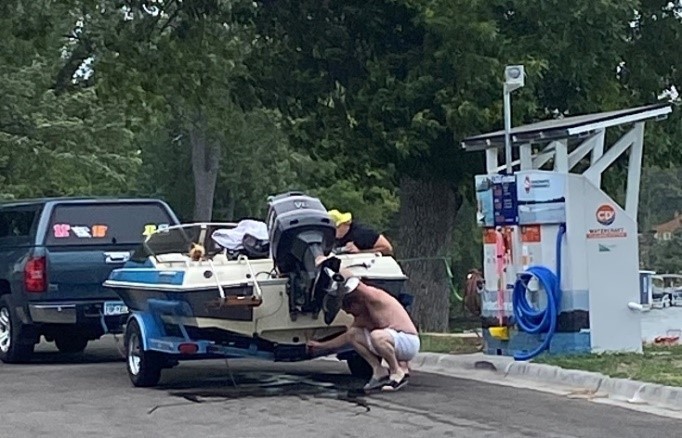 Boater using a CD3 station installed at the Mississippi River access in Champlin this year
Strategies include
- Pavement markings to influence traffic flow.
- Designated locations to take AIS prevention actions.
- Signs to prompt the desired behaviors, and
- Self-service waterless cleaning systems that provide the tools for boaters to take appropriate actions.
CD3 (clean, drain, dry) stations, first piloted in 2017, can record tool uses. We are excited to report that we have now recorded over 100,000 tool uses by the public countywide! In 2021 alone, over 23,000 total tool uses were recorded. Riley Lake in Eden Prairie takes the top place with a total of 20,513 uses since their install in September of 2017. Boaters are using these tools to help remove plants and other organisms from their boats, trailers, and equipment. Several different tools are available depending on the station.
Tool uses at CD3 stations
Air
|
Brush/weed- hook
|
Grabber
|
Light
|
Plug wrench
|
Vacuum
|
Total
|
| 16,460 |
25,711 |
27,659 |
5,561 |
14,914 |
9,973 |
100,278 |
| 16% |
26% |
28% |
6% |
15% |
10% |
This was only accomplished through county-wide partnerships! We plan to hold a celebration event in spring of 2022!
CD3 stations are located at the following accesses, in partnership with the listed organization. The year listed is the year the station was installed.
- Bryant, Three Rivers Park District (TRPD) - 2017
- Bush, City of Bloomington - 2018
- Eagle, City of Maple Grove & Lake Association - 2021
- Fish, TRPD & Lake Association - 2020
- Grays Bay (coming in 2022), LMCD, City of Minnetonka & MN DNR
- Little Long, MN DNR & Voyagers camp - 2019
- Long, City of Long Lake - 2018
- Medicine, TRPD - 2019
- Mississippi Point Park, Mississippi, City of Champlin - 2021
- Mitchell, City of Eden Prairie - 2021
- North Arm, Minnetonka, Hennepin County - 2017
- Parkers, City of Plymouth - 2018
- Riley, City of Eden Prairie - 2017
- River Park, Mississippi, City of Brooklyn Park - 2021
- Sarah, City of Independence & Lake Association - 2018
- Spring Park, Minnetonka, Hennepin County - 2017
- Twin, TRPD - 2021
- Weaver, City of Maple Grove and Lake Association - 2018
If you haven’t used a CD3 station, plan to try one next year.
It was a very hot day in July when a group gathered at the historic Bush Lake Izaak Walton League (IWL) lodge for a workshop on aquatic invasive species in late July.
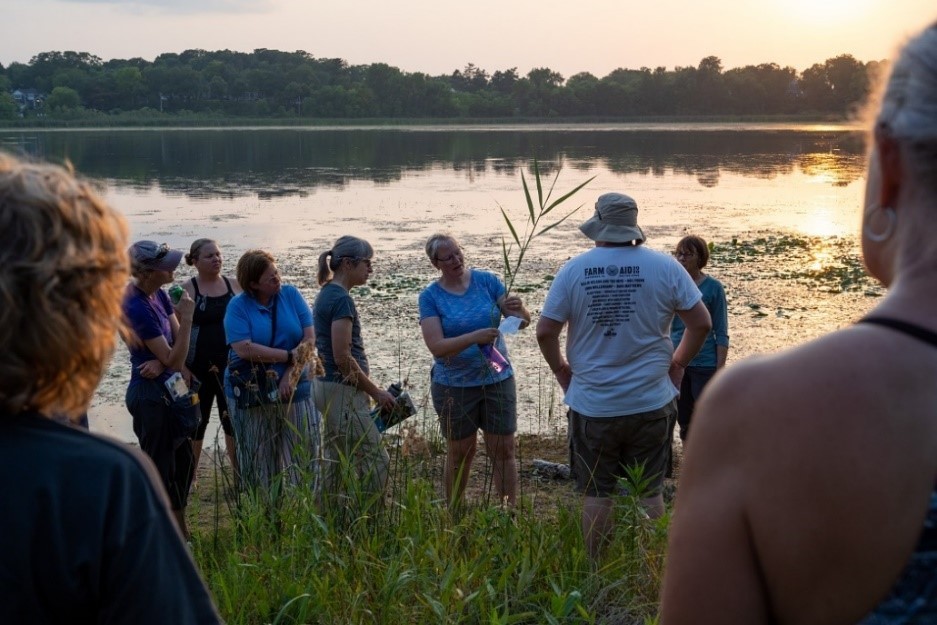 Examining a suspected invasive Phragmites plant found on the shoreline.
Photo credit: Paul Raymaker, Bush Lake Izaak Walton League
The training began with an indoor session. Although the lodge is not air conditioned, and most windows don’t open, the group seemed up for a learning experience and toughed it out. Following a short presentation by Paul Erdmann from the IWL, Carolyn Dindorf of Fortin Consulting presented information on invasive species and how to monitor for and identify them. Preserved and fresh samples of AIS and similar native species were set out on tables for all to see and touch. Following the indoor session, the group moved outside to the beautiful shoreline and searched for AIS and other species. Participants enjoyed wading in the water to cool down after the indoor session.
Invasive Phragmites discovered
A clump of invasive Phragmites plants were identified along the shoreline. Phragmites is a tall grass that has both a native and invasive genotype in Minnesota. The invasive Phragmites australis subsp. australis (European reed grass) can aggressively spread in wetlands, shorelines and ditches and crowd out native species. Paul Erdmann, who manages the IWL property, removed the seed heads to prevent spread and will treat it next year. He also reported the find to the Department of Natural Resources using the EDDMaps program.
This workshop may occur annually. If you are interested in notification about future workshops, please contact Tony Brough or Carolyn Dindorf.

In 2021, Fortin Consulting staff joined Edward Lake and Lake Independence volunteer monitors, providing monitoring equipment and helping them identify plants and other species pulled up during rake tosses or found along the shore. Fortunately, no new AIS infestations were reported to the DNR for Hennepin County in 2021. Did you remember to check your dock poles, boat lifts, and boat for zebra mussels when you pulled them out of the water this year? It is not too late. Many zebra mussel infestations have been found by checking docks and other equipment. If you got out and searched for AIS this year, please notify Tony Brough or Carolyn Dindorf so we can track what monitoring is occurring. Even if you did not find anything, we would like to hear from you.
|
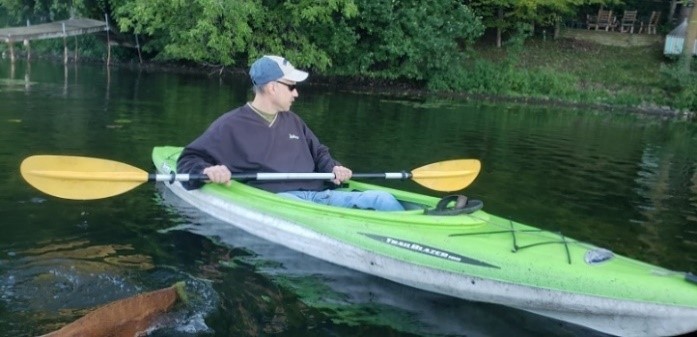 Searching for AIS by kayak in Edward Lake, Maple Grove
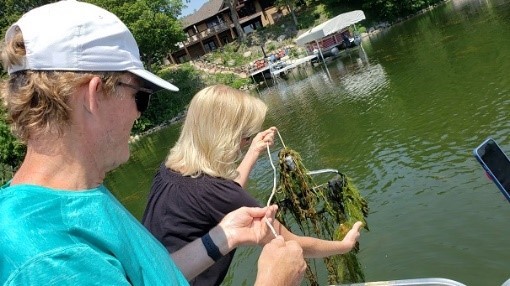 Lake Independence Members using a weed rake in Lake Independence
The May AIS newsletter included an article about a study of invasive species found in pet stores and garden centers in Hennepin County. That study has been completed and the results are in. One hundred percent of the 20 pet stores and 78.6% of the 14 garden centers in Hennepin County were found to carry regulated or prohibited species. Here are the species found for sale in Hennepin County:
Plant or animal
|
Pet Stores
|
Garden Centers
|
DNR status
|
|
Red swamp (Louisiana) crayfish
|
X
|
|
Prohibited
|
|
Yellow-floating heart
|
|
X
|
Proposed prohibited
|
|
Goldfish
|
X
|
|
Regulated
|
|
Koi
|
X
|
|
Regulated
|
|
Red-eared slider turtle
|
X
|
|
Regulated
|
|
Brazilian waterweed (Egeria or Anacharis)
|
X
|
|
Regulated
|
|
Cabomba (Carolina fanwort)
|
X
|
|
Regulated
|
|
Water lily (non-native varieties)
|
X
|
X
|
Regulated
|
|
Water hyacinth
|
|
X
|
Regulated
|
|
Water lettuce
|
|
X
|
Early detection target
|
Checking Hennepin County pet stores and garden centers has been an ongoing project to determine what is being sold in retail stores and also to provide education and awareness to prevent introduction of invasive species through the pet and garden center sectors.
In 2015, 88% of the pet stores and 94% of the garden centers visited were selling regulated species. Two regulated plant species that were found for sale in 2015 were not found in the 2021 study (parrot’s feather and yellow iris). In a follow-up check in 2017, a prohibited fish species, gold dojo loach a.k.a. oriental weatherfish was found in several Hennepin County pet stores. It was not found in the 2021 study.

In 2021, a crayfish believed to be the prohibited species Procambarus clarkii, also known as red swamp or Louisianna crayfish, were identified for sale at two pet stores. The Department of Natural Resources (DNR) was notified of the original finding. The crayfish was sent to an expert at Michigan State University who confirmed the identification. The stores and supplier have been notified of the prohibited status, informed by the DNR that it can not be sold or possessed in Minnesota, and they have cooperated.
|

Nineteen pet stores carried goldfish and 17 carried koi which grow quickly and can outgrow their aquariums posing a problem for pet owners. It may be difficult for someone to euthanize a pet, including fish, and some are released into the wild. Although regulated species are legal to sell, they cannot legally be released into the wild. These non-native species, along with other invasive plants and animals sold in the pet stores and garden centers, can reproduce and damage lakes, wetlands and streams. The next article in this newsletter discusses the damage released goldfish are doing to Lake Cornelia in Edina.
The 2021 observations were discussed with store managers or staff. Handouts were provided including the most recent DNR list of invasive species and disposal guidelines.
|
If you have an unwanted fish or other pet, contact your local pet store to see if they will take it back, many will. The Minnesota Aquarium Society holds events where they will take unwanted fish, plants and other aquarium species and sell them at their auction. Aquatic plants should be frozen and disposed in the trash. Contact Carolyn Dindorf for more information on this AIS study or a similar statewide study completed for the DNR looking at AIS in pet stores and seafood markets.
Large populations of goldfish are living in Edina’s largest waterbody, Lake Cornelia. Goldfish are a regulated invasive fish and are detrimental to water quality and the ecological health of surface waters. Goldfish adapt to their surroundings after about a year, losing their bright color and growing large enough that predators choose not to hunt them. Due to their bottom feeding habits, goldfish stir up sediments in lakes, resulting in lower water clarity, phosphorus release, and algal blooms. They uproot vegetation which ruins habitat for native aquatic species and creates habitats that are more susceptible to invasive plants.
 Large goldfish caught during a survey on Lake Cornelia.
Photo credit: Nine Mile Creek Watershed District
A 2018 fish survey conducted in Lake Cornelia showed that goldfish populations may exceed 30,000 fish and management practices were recommended to protect water quality. A follow up study, featured on the TV show Minnesota Bound, was conducted in 2020 to assess the number of goldfish present and track their movement through the lake. Surveyors utilized electrofishing practices and netting to count fish present in each area and attached individual trackers to follow fish movement. Understanding movement patterns gives needed insight for more successful management. The study, partly funded by Hennepin County, will continue through 2022 to remove some goldfish, track results, and determine the best way to eradicate the goldfish population.
The public can help in management efforts by making sure to never dispose of unwanted aquarium fish into water bodies. Volunteer goldfish removal opportunities are available through the Nine Mile Creek Watershed District during the summer. Contact Erica from Nine Mile Creek to learn more about how you can get involved! Learn more about the Lake Cornelia improvement project.
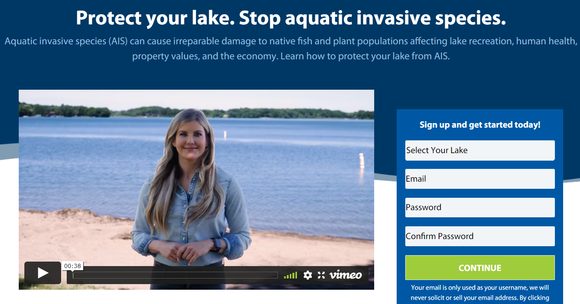 In 2021, county staff and three lakes in Maple Grove piloted an exciting and innovative AIS prevention website for lakeshore homeowners! The communication within the website is personalized, is celebrity endorsed, and uses a trusted messenger: the neighbors of lakeshore homeowners. The site ultimately helps to create a lake wide commitment, fun statistics celebrating lake activities, and best of all, it’s mobile friendly!
From the 2021 pilot, the current lakeshore property ownership participation has Weaver Lake at 56%, Cedar Island at 27%, and Fish Lake at 22%!

Lake Pledge testers stated, “So innovative and simple…took me 15 minutes to do” “I’m sure the lakeshore owners will be proud and recognize the value this adds to their lives.” and “Super cool, video messages are great.”
County staff are excited to make this website available to all interested lakes in Hennepin County in 2022. This educational tool will help lakeshore homeowners to make their lakes “Legendary” in the basics of AIS prevention. Stay tuned in this newsletter for information on how to get your lake added to the app in 2022.
Contact Tony Brough if you are interested in learning more about the website and getting your lake added to it in 2022.
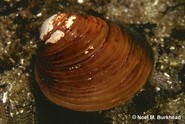
Asian clams, also known as golden clams, (Corbicula fluminea) were discovered in Briggs Lake in Sherburne County this summer by a 12-year-old boy during the annual Starry Trek volunteer search for starry stonewort and other invasive species. The clams had previously only been found in rivers where there is warm water discharge such as from power plant cooling systems.
The Asian clam is a small bivalve that is normally about 1 inch but can grow up to 2 inches in length. Coloration varies from light yellow or yellow/green to light brown and shells have raised concentric ridges and fine serrations on the lateral teeth (inside the right shell). They can be introduced to Minnesota through the aquarium, bait, and food trades and can rapidly reproduce, each adult producing 1,000 to 100,000 juveniles each year through self-fertilization. Asian clams cause biofouling in intake pipes and secrete nutrients that could stimulate algal growth. There is currently no feasible treatment method that doesn’t also harm native mussels.
Researchers from the Minnesota Aquatic Invasive Species Research Center will be surveying Briggs Lake over the winter and through the summer of 2022 to evaluate their overwinter survival and reproduction as well as potential to spread to other lakes or streams. The Asian clam is not currently regulated in Minnesota, but the DNR is planning to propose it be listed as a prohibited species.
|
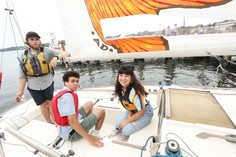
Local government agencies, nonprofit organizations, institutions, and businesses in Hennepin County can apply now for funding to implement projects that prevent the spread of aquatic invasive species.
Grant funding can be used to address pathways of aquatic invasive species introduction, provide education, promote behavior change, implement early detection and rapid response efforts, and other ideas that prevent the spread of aquatic invasive species.
Review the grant flyer (PDF) for more details. Applications are due by Thursday, January 13, 2022. Learn more and apply.
For more information, contact Tony Brough at tony.brough@hennepin.us or 612-348-4378.
|
If you were forwarded this email and would like to subscribe:
- Click this link
- Click through the prompts to open a list of newsletter subscription options
- Open the Environment option
- Click the Aquatic Invasive Species: Early detectors newsletter to subscribe
Hennepin County AIS training and technical assistance contacts:
Tony Brough, Hennepin County AIS coordinator, brough@hennepin.us, 612-348-4378
Carolyn Dindorf, Fortin Consulting, Inc., carolyn@fortinconsulting.com, 612-220-4999
|